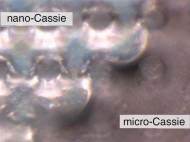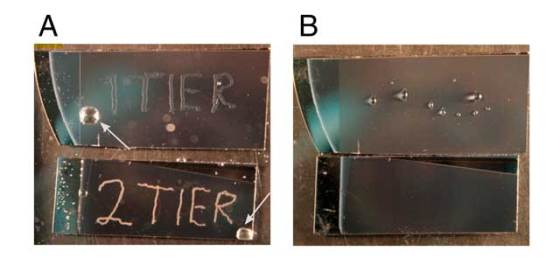Using water and air to create bistable optical displays
 An international team of researchers led by Aalto University have come up with a concept of writing and displaying information on surfaces using simply air and water. The researchers are using an interesting property of superhydrophobic surfaces when they are submerged into water. The microscopic structures on their surface prevent the water from contact with the material and trap the air which was in contact with the surface when the material is submerged.
An international team of researchers led by Aalto University have come up with a concept of writing and displaying information on surfaces using simply air and water. The researchers are using an interesting property of superhydrophobic surfaces when they are submerged into water. The microscopic structures on their surface prevent the water from contact with the material and trap the air which was in contact with the surface when the material is submerged.
Aside being used to create dirt and bacteria free surfaces, lotus flower served as inspiration for the development of this concept since its dual-structured hydrophobic (water-repelling) surface is superhydrophobic. Led by Dr. Robin Ras at Aalto University in Finland, the researchers from the University of Cambridge and Nokia Research Center Cambridge created the interesting two-level surface.
The surface consists out of a layer of ten-micrometer microposts and tiny nanofilaments that are grown on the posts. This two-level surface allows the trapped air to exist in two different shapes (wetting states) which can fit into these sizes. The shift between two states proved to be easy with usage of a nozzle which creates local over- or underpressure in the water, thus changing the wetting state of the trapped air and causing an interesting effect to take place.
The method for manipulating the air layer with the nozzle was developed by Aalto University’s graduate student Tuukka Verho. He was able to demonstrate that the change between states is reversible and that it can be done with precision in a pixel-by-pixel fashion. The switching only involves a change in the shape of the air layer − nothing happens to the solid surface itself.
Aside the fact that the technology requires a minimal amount of energy to change the states since it is related to pressure control, and the fact the system has bistable properties since the trapped air makes this surface ‘remember’ the state it is in, the most interesting feature of their concept is the striking optical contrast between the states which occurs due to the change in the bumpiness of the water-air interface.
That means that you can use the nozzle as a pencil or an eraser and write shapes on the surface while it is submerged into water. Once the surface is pulled out from the water, it becomes completely dry, and no traces of the writing remain.
This research is a landmark example how we can use nature to create functional materials. Aside potential use in entertainment where bistable underwater reflective boards could use an array of nozzles that ‘print’ different images or information in order to attract the public, the technology could eventually find its use in information storage and processing. If the memory ability of these surfaces proves to be durable, it could be used in low-power chemical-mechanical devices for long information storage.
For more information, you can read the article published in PNAS: “Reversible switching between superhydrophobic states on a hierarchically structured surface” [1.36MB PDF].










Very interesting, I can see this being used in marketing purposes. And the liquid temperature could be used to additionally cool or warm the space around the tank.